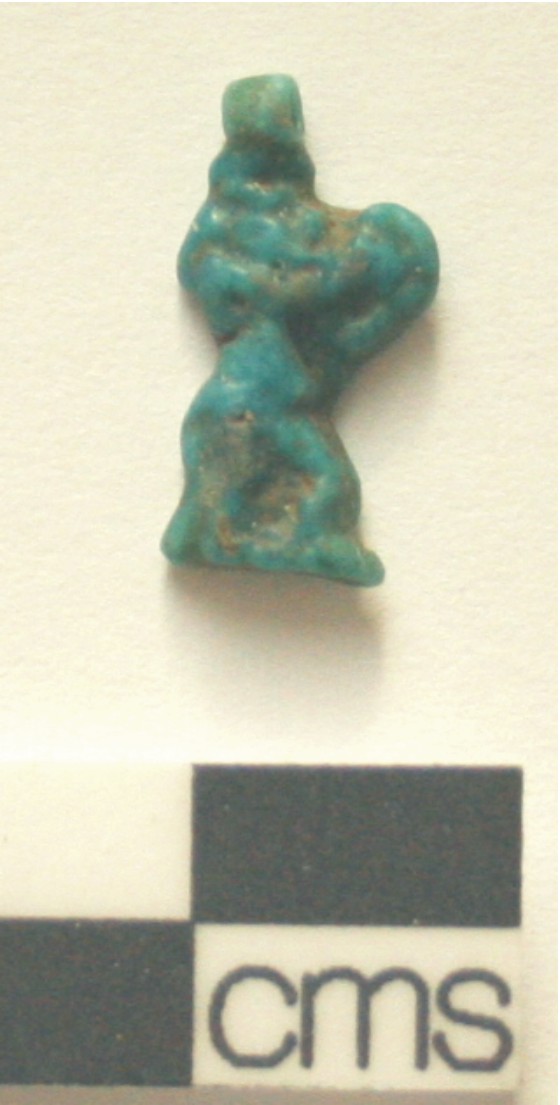Bes
Bes
 Bes is usually shown as a dwarf deity with a lion type mane and tail and bandy legs. He often has his tongue sticking out and may be holding a knife or his tail. Sometimes he holds the ‘sa’ protection sign or is shown playing a round hand-drum drum or tambourine (from later depictions where the object can be seen more clearly this looks like a hand-drum). His ugliness was possibly meant as a deterrent to evil spirits. Unlike most other gods, Bes is always shown full face.
Bes is usually shown as a dwarf deity with a lion type mane and tail and bandy legs. He often has his tongue sticking out and may be holding a knife or his tail. Sometimes he holds the ‘sa’ protection sign or is shown playing a round hand-drum drum or tambourine (from later depictions where the object can be seen more clearly this looks like a hand-drum). His ugliness was possibly meant as a deterrent to evil spirits. Unlike most other gods, Bes is always shown full face.
The name Bes is used to describe a number of similar deities and demons which vary at different periods. Quirke (1992, 108) summarises the history of the deities: In a limestone relief of c. 2400 B.C. a male figure is shown with a lion head in a register called ‘dancing with children’. In the Middle Kingdom a leonine dwarf appears with the label Aha ‘the fighting deity’ on carved ‘magic wands.’ In the 18th Dynasty and later he appears in amuletic form (you can see examples in the Egypt Centre). These amulets were worn in life, mainly by women and children, but also appear in the tomb. It is however, not until later periods that the lion-maned dwarf god and his female counterpart are named as Bes and Beset.
In the New Kingdom Bes is often shown connected with domestic buildings such as at Deir el-Medineh. In the houses there he is painted on walls, perhaps due to his connection with women (Manniche 1987,18). In addition, one of his main roles was as a protector of women in childbirth and of young children. He is shown in scenes of royal birth on the walls of Theban temples.
He is also associated with bedroom furniture and appears on beds, headrests, chairs, mirror handles and other cosmetic items. In the Egypt Centre ‘House of Life’ there is a bed or chair leg showing Bes.
Bes tattoos are shown on models of swimming girls and on reliefs depicting dancers and musicians. The tattoos are shown on the thighs. Some Egyptologists have suggested that the Bes tattoo was only worn by dancers. However, Vandier d’Abbadie has shown that this was not the case (1938, 31).
Bes often appears on vases. There are examples in the Egypt Centre of this. He may have appeared on vessels associated with drinking because of his joyous nature.
Some of the items in the Egypt Centre related to Bes:
W961p Pendant showing Bes with drum or tambourine
W2052 Bed legs showing Bes and Taweret
W1151 A ring bezel showing a dancing Bes (Amarna)
W1156 an unusual Bes head from Amarna
Bell in the shape of a Bes head
Further Reading
Hart, G., 1986. Dictionary of Egyptian Gods and Goddesses.
Malaise, M. 1990. “Bes et les croyances solaires”, in Israelit-Groll, S. (ed.), Studies in Egyptology Presented to Miriam Lichtheim, Jerusalem, pp. 680-729.
Manniche, L. 1987. Sexual Life In Ancient Egypt. London and New York: Kegan Paul.
Quirke, S., 1992. Ancient Egyptian Religion. London: British Museum.
Romano, J.F., 1980. ‘The origin of the Bes image’, Bulletin of the Egyptological Seminar 2, 39-56.
Sadek, A.I., 1987. Popular Religion in Egypt during the New Kingdom. Hidesheim: Pelizaeus Museum.
Vandier d’Abbadie, J., 1938. Une fresque civile de Deir el-Medineh. Revue d’Egyptologie.